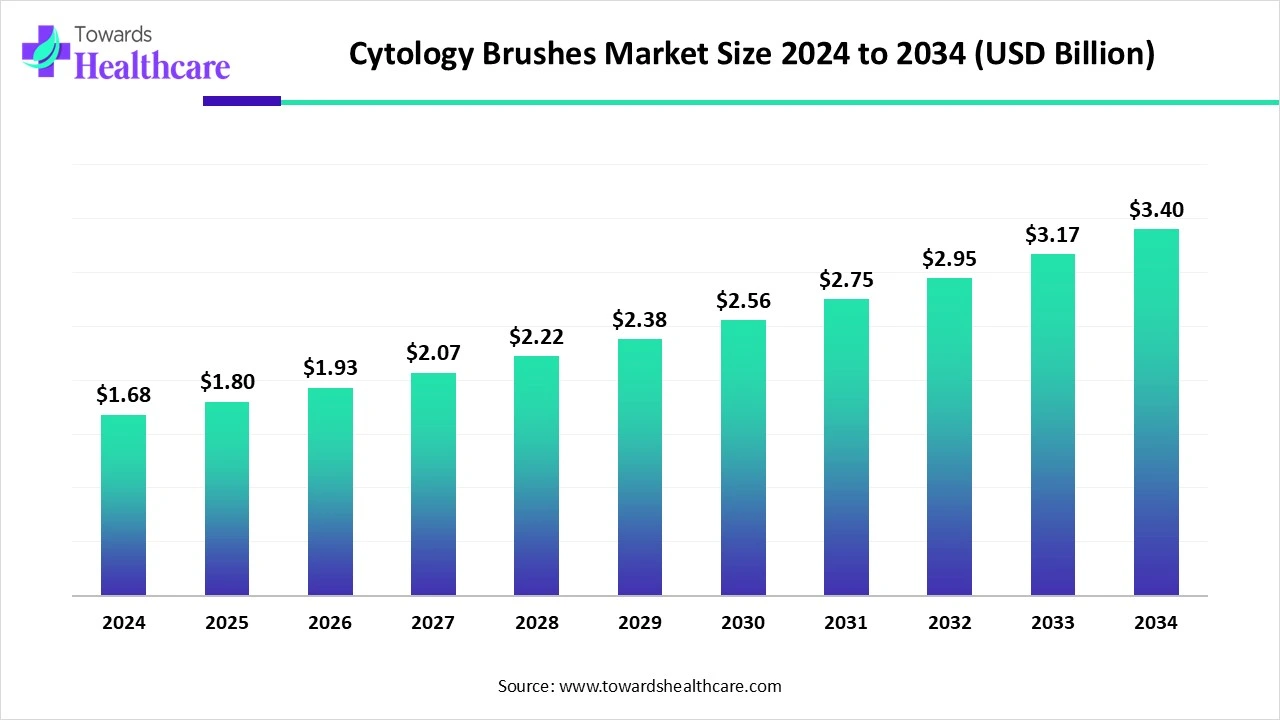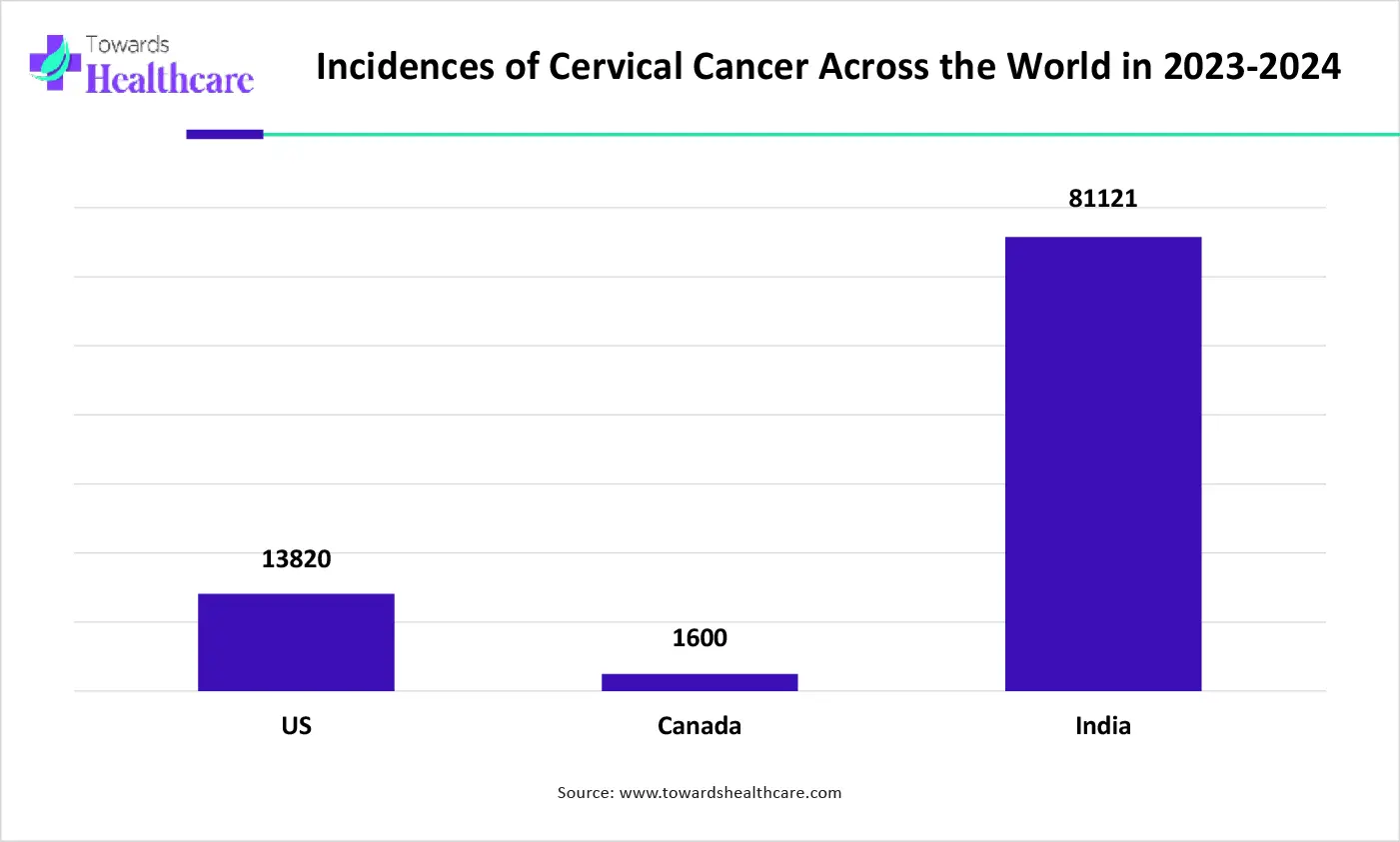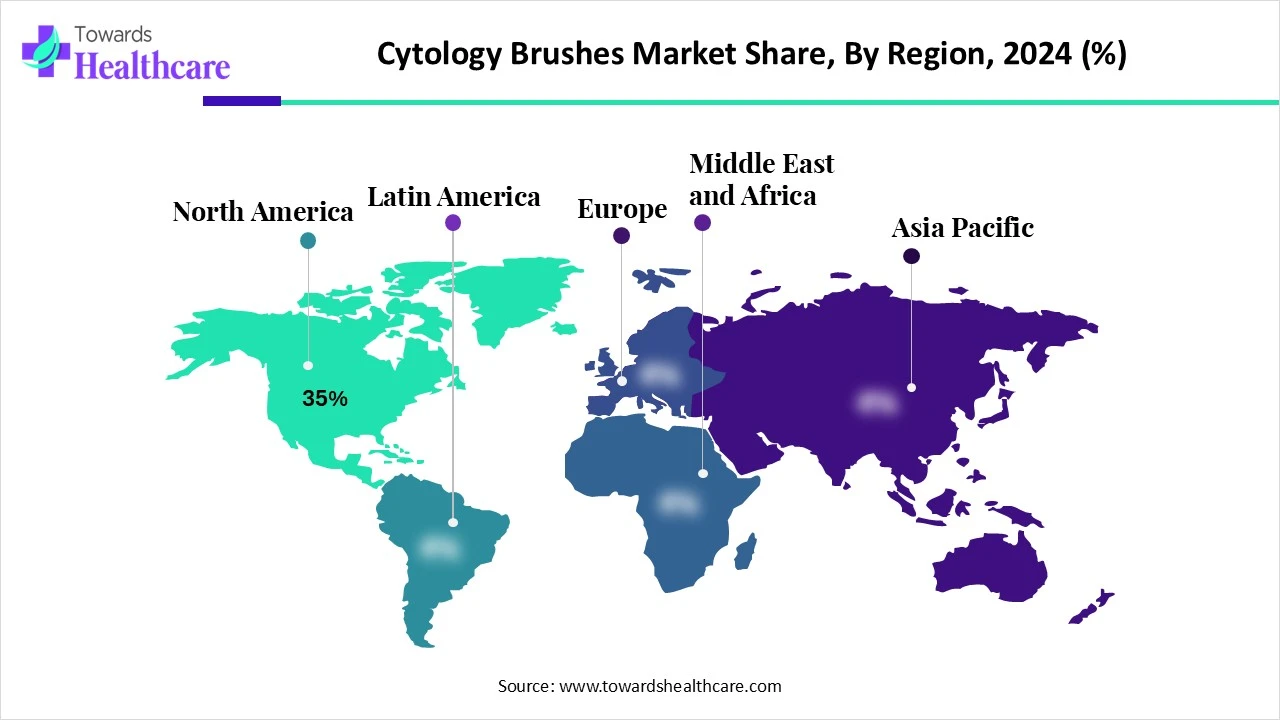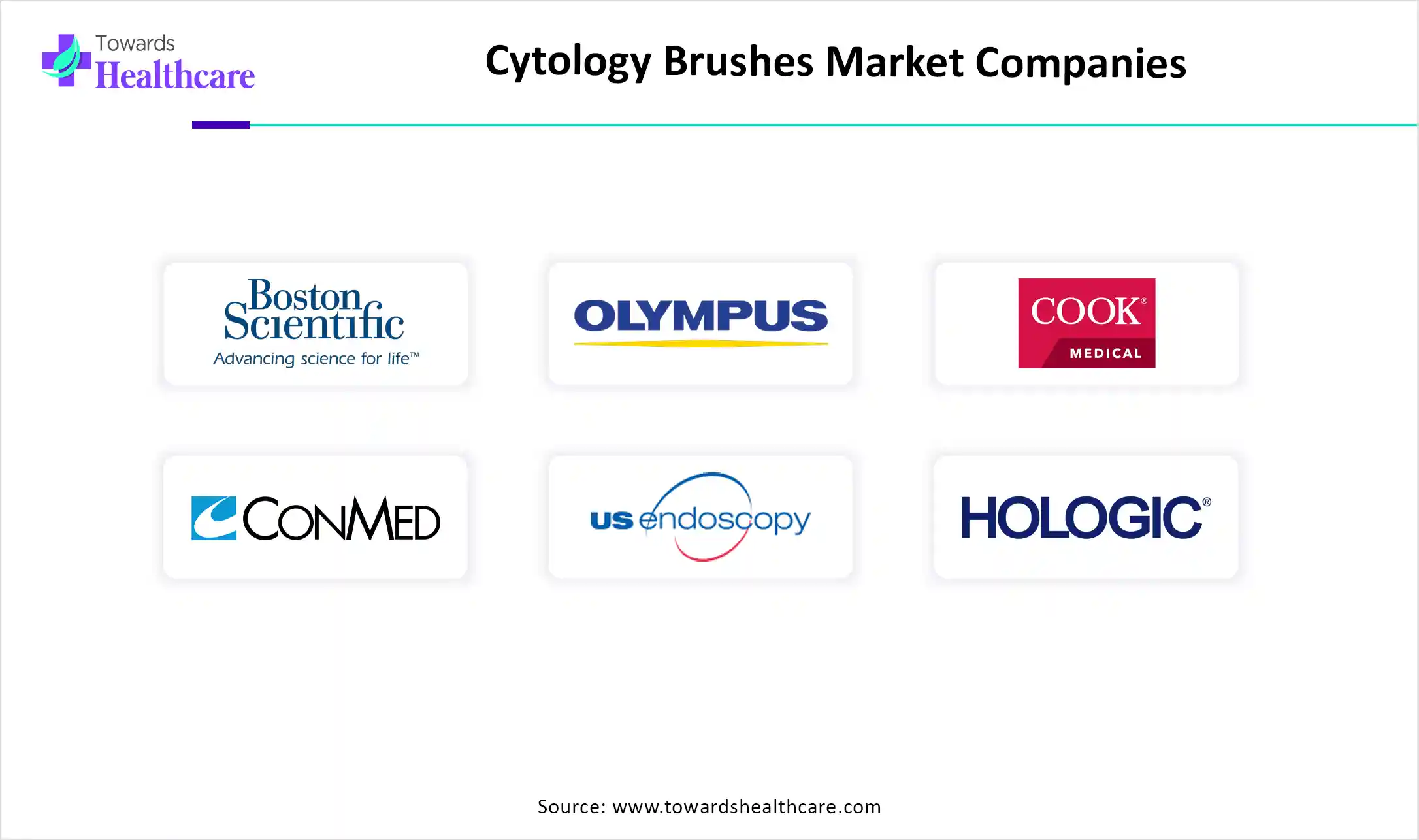November 2025

The global cytology brushes market size is calculated at US$ 1.68 in 2024, grew to US$ 1.8 billion in 2025, and is projected to reach around US$ 3.4 billion by 2034. The market is expanding at a CAGR of 7.36% between 2025 and 2034.
The global cytology brushes market has been experiencing tremendous growth due to the involvement of several factors, such as rising cancer incidences like cervical cancer, pulmonary cancer, and gastrointestinal cancer, which are boosting the early disease diagnosis and the adoption of minimally invasive procedures. These approaches are widely demanding for cytology brushes to accelerate accurate diagnosis and patient comfort. Besides this, Globe is emphasizing innovations in soft-brush heads, advanced techniques like endoscopy with the use of user-friendly and biocompatible material.

| Metric | Details |
| Market Size in 2025 | USD 1.8 Billion |
| Projected Market Size in 2034 | USD 3.4 Billion |
| CAGR (2025 - 2034) | 7.36% |
| Leading Region | North America share by 35% |
| Market Segmentation | By Product Type, By Material, By Application, By End User, By Region |
| Top Key Players | Boston Scientific Corporation, Olympus Corporation, Cook Medical, ConMed Corporation, U.S. Endoscopy, Teleflex Incorporated, Hologic, Inc., Becton, Dickinson and Company, Medi-Globe GmbH, Hobbs Medical Inc., Cardinal Health, Mil-Rose Laboratories, Sanderson MacLeod, Cantel Medical, EndoChoice Inc., Diagmed Healthcare, Thermo Fisher Scientific, Tele Med Systems, Inc., Medovation Inc., Medis Medical |
The cytology brushes market refers to the global industry involved in the production and distribution of medical brushes used to collect cell samples from various body sites, such as the cervix, gastrointestinal tract, respiratory tract, and urinary tract for diagnostic purposes, including cancer screening and infection detection. Generally, this market is driven by increasing cases of chronic conditions such as cancer, advancements in diagnostic technologies, and rising focus on prior disease diagnosis. Major innovations in brush design, including soft-brush heads and ergonomic designs, are ongoing developments in the market to boost diagnostic accuracy and patient comfort.
Around the world, increasing incidences of cancers and growing awareness among healthcare professionals about early cancer detection, including cytology brushes, fuel the adoption of AI, especially in escalating diagnostic accuracy and efficiency. As well as the inclusion of machine learning (ML) and deep learning (DL), they are unified into cytopathology to examine cell samples collected by cytology brushes, resulting in quick diagnoses and enhanced quality. Furthermore, these things are impacted by factors, like accurate medical trends, demand for more precise diagnostics, and the progressing use of AI-powered tools for cell analysis.
For instance,
Accelerating Prevalence of Cancer and Demand for Minimally Invasive Procedures
In 2025, a global rise in cancer cases, particularly lung and cervical cancer, as well as other issues like respiratory diseases, urological disorders, and other cytological diseases, is expected to represent a major driver in the cytology brushes market. In addition, a growing shift towards minimally invasive diagnostic procedures is boosting the demand for these brushes in the collection of cell samples in the same methods. Also, novel cytology brush designs, such as soft-bristled heads and enhanced specimen collection techniques, are helping to boost diagnostic accuracy and patient comfort.
Combined Factors Raising Limitations
Basically, the developing challenges in the market are contributing combined factors, including a strict regulatory landscape, expensive advanced cytology brushes and procedures, with a shortage of trained and expert personnel in using these brushes. As well as restricted sensitivity and specificity of cytology brushes may affect clinical preferences.
Ongoing Technological Breakthroughs and Applications in Various Areas
Significant opportunities emerging in the cytology brushes market are novel creations in brush design, with soft-brush heads and improved specimen collection techniques, with increasing demand for endoscopic procedures are broadly influencing market growth. Additionally, in this era, rising initiatives by the government and increasing healthcare awareness will actively promote early disease diagnosis with the aid of cytology brushes. These will be widely incorporated in bronchial cytology, biliary tract cancers, including cholangiocarcinoma, and cervical cancer screening, with advancements in liquid-based cytology further propelling market growth.
By product type, the disposable brushes segment held a major share, with major technological advancements in endoscopic equipment, like optimized brush designs, and a rising trend of Liquid-based cytology (LBC) for optimal cell collection are driving the overall segment growth. This innovative brush design also consists of biodegradable materials in brush manufacturing, which is fueling demand for this kind of brush.
Although the reusable brushes segment will expand rapidly during 2025-2034, due to its crucial benefits, including being more affordable, highly environmentally friendly, aligning with growing sustainability concerns, and specific applications in unique features or performance characteristics, coupled with a sterilization approach, are driving the segment expansion.
The polypropylene/nylon segment held a ~40% share in the market in 2024, as this material is a popular choice for the bristles of cytology brushes because of its flexibility, sustainability, and ability to collect adequate samples. Also, polypropylene has features like lightweight and affordable are making it user-friendly, and ultimately enhancing its demand.
Whereas, the silicone brushes segment is estimated to grow fastest, with its wide-range advantages, such as biocompatible material, with enhanced durability. Along with this, silicon possesses resistance to various chemicals, reducing the risk of contamination, with non-porous bristles that maintain hygienic properties, and versatility, including medical, automotive, construction, and consumer goods, is fueling demand for silicone material.
By application, the gynecological screening segment led the cytology brushes market, due to the growing prevalence of cervical cancer across the globe, which is impelling demand for cytology brushes used in Pap smear tests and other cervical screening procedures. Besides this, increasing awareness about this cancer and the importance of early detection, along with government-backed screening programs, are impacting overall market expansion.
And, the gastrointestinal/respiratory sampling segment will show rapid growth in the coming years. The segment is propelled by growth in the geriatric population associated with chronic concerns, including respiratory diseases and cancer. Inclusion of innovations in endoscopic technology, like the development of smaller and more flexible endoscopes, which allow better access to deeper and more limited areas of the gastrointestinal and respiratory tracts, is fueling the expansion of the segment.

By end user, the hospitals segment held nearly 60% share in 2024. Influenced factors are that hospitals are key users of these brushes, especially for endoscopic procedures in oncology and pulmonology, along with the raised adoption of novel brush design and sampling efficiency, including advancements in automated diagnostic platforms, are driving the overall market expansion.
Whereas, the ambulatory surgical centers segment will register rapid growth, with its cost-effective property and simplified operations. Moreover, rising choice for minimally invasive procedures and shorter recovery times are accelerating the movement towards ambulatory surgical centers. Also, in the increasing geriatric population associated with cancer and other conditions, ASCs are playing a crucial role.

North America was dominant in the market share by 35% in 2024. The region has emphasized prior disease detection and preventive healthcare practices, which support the use of cytology brushes for screening and diagnosis, particularly in cervical and respiratory cancers. As well as North America, focusing on the expansion of healthcare infrastructure and the availability of healthcare services, particularly in underserved areas, facilitates the adoption of cytology brushes.
The majorly impacted country in North America is the US, which has targeted its high healthcare expenses with advanced infrastructure, with numerous hospitals and outpatient centers equipped with cytological diagnostic tools, facilitates access to screening procedures and contributes to market expansion, and has a robust focus on preventive care.
For this market,
Canada has also major contribution to the market expansion, due to its adoption of healthcare advancements and minimally invasive procedures. Additionally, government and healthcare initiatives in growing awareness about cancer and other diseases, along with screening programs, are boosting the demand for cytology brushes.
For instance,
Asia Pacific is predicted to expand at a rapid CAGR during 2025-2034, due to rising awareness of the significance of early cancer diagnosis via cytology screening approaches, with minimal invasive and affordable than tissue biopsies. Along with this, ASAP has emerging research and development in cytology brush design, and governments are stepping towards cancer screening programs, and a growing number of trained healthcare professionals are escalating the development of the cytology brush sector.
India has been facing an immense growth in cervical and respiratory cases, which is demanding that prior cancer detection is a vital driver for growing cytology brush expansion. Furthermore, the increasing trend towards the development and use of disposable cytology brushes in India, with advancing healthcare infrastructure, is driving the respective market growth.
For this market,
In Japan, the market is fueled by enormous growth in an aging population with rising demand for oncology and respiratory-related diagnostic tools, as well as an accelerating preference for minimally invasive diagnostic procedures, such as endoscopy are enhancing demand for cytology brushes with novel breakthroughs.
For instance,
In the world, Europe is experiencing a significant market growth, due to the increasing different cancer cases, such as cervical, lung, and gastrointestinal cancers, which are enhancing the adoption of affordable and novel cytology brushes. As well as developing promotions by European governments in preventive healthcare and early disease detection, in addition to innovations in soft-brush heads, optimized specimen collection techniques with AI integration are propelling the market development.
Germany, with robust healthcare facilities and infrastructure, focuses on development in novel endoscopy technology and cytology techniques, like liquid-based cytology and automated systems, which are boosting the effectiveness and efficiency of cytology procedures. Also, Germany has widely adopted liquid-based cytology approaches, which are increasingly in demand for cytology brushes with a minimally invasive method.
The UK possesses modernized healthcare facilities, along with the UK government raising awareness regarding cancer screening and promoting regular checkups are broadly contributing to the increased adoption of cytology brushes.
For instance,

By Product Type
By Material
By Application
By End User
By Region
Cardiac biomarkers like troponin, CK, and myoglobin help diagnose heart attacks by detecting damage to the hea...
November 2025
November 2025
November 2025
November 2025